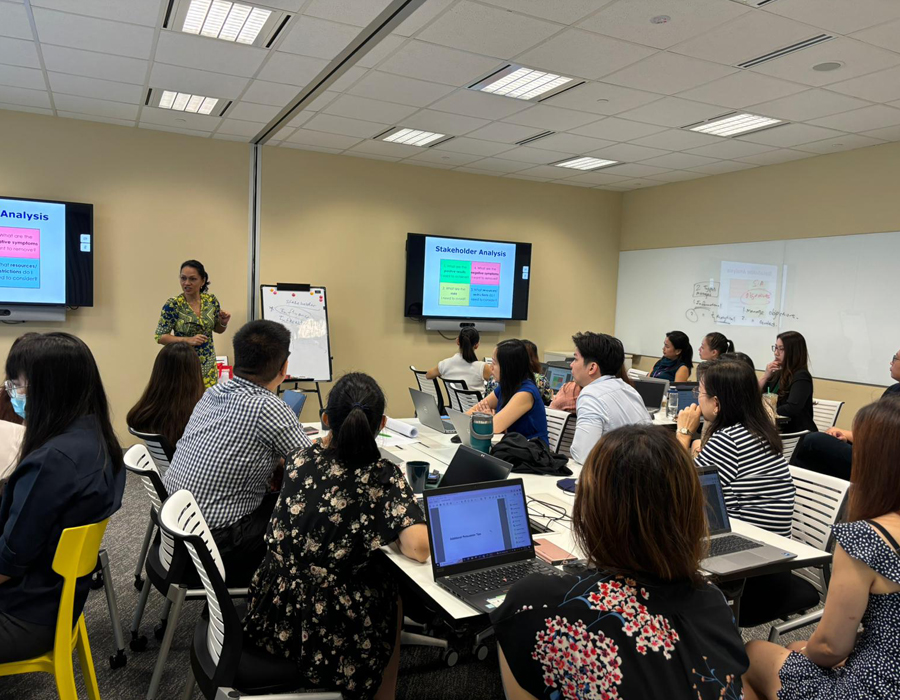
Building a Proactive Mindset for Maximum Effectiveness
Effective communication of change to stakeholders is essential for successful organizational transformation. It involves informing, engaging, and supporting stakeholders throughout the change process to ensure alignment, minimize resistance, and foster a positive transition.
This programme helps you to learn how to recognise your own mindset and the key strategies to change them. The objective is to equip you with the strategies to transform your mindset to be more effective at work and to have clarity on how to successfully transition through the transformation process that organisations are currently facing.
This high-energy back-to-basics training program explains the fundamentals of personal management. This workshop also will help participants to recognize how we place pressure on ourselves and how one can regain balance in our lives. Participants will also have an armory of strategies for maintaining physical and mental energy levels throughout the day to sustain peak performance.
OBJECTIVES
- How to develop a proactive mindset by being adaptable and flexible with continuous changes.
- Being mindful of one’s daily peak performance by maintaining physical and mental energy levels.
- Adopting effective decision-making techniques by analysing situations objectively and making informed choices for personal and professional goals/objectives.
- Fostering a culture of continuous improvement by seeking feedback for personal development.
OUTLINE
Managing Oneself
- Identify the causes of procrastination and remedies for solution.
- Dealing with things that are important, but have no time for.
- Cast off familiar and comfortable yet unproductive activities.
- The time management matrix.
- Differences between urgency and important activities.
- Prioritising.
- Quadrant 2 challenges.
- Living effectively in Quadrant 2.
Mindfulness and Focus
- Understanding stress, effects and performance levels.
- Stress reduction techniques using physical, mental, emotional and spiritual levels.
- The 4 basic areas of achieving balance and renewal.
- Achieving a balanced lifestyle.
- Making time for personal development.
- Gentle reminder on managing peak performance with priority management.
Cultivate Adaptability & Flexibility
- Change at the personal and organisational level.
- The link between mindset and change.
- Develop strategies to change mindsets.
- Understanding and applying “Who moved my cheese” concepts: How to overcome change? How good do you think you will feel when you move beyond your fear to find your “New Cheese”? What changes are occurring in your industry or your life that will help you see what you are doing is old and ineffective?
Uncover Potential with Proactive Goal Setting
- Cycle of negative self-talk and false assumptions.
- How to control negative self-talk.
- Setting positive and strategic affirmation.
- Set your personal goal and objectives.
Final Review of Learning
- Debrief and application of learning points in the workplace.
- Questions and answer session.
- Moving forward—Personal action plans for application of learning.
DURATION
One Day
Communicating Change to Stakeholders
Introduction
Effective communication of change to stakeholders is essential for successful organizational transformation. It involves informing, engaging, and supporting stakeholders throughout the change process to ensure alignment, minimize resistance, and foster a positive transition.
OBJECTIVES
- Understand people’s mindsets.
- Understanding change at the personal level.
- Recognize the link between mindset and personal change.
- Understand and apply mindset change strategies at work.
OUTLINE
Forces of Change
- The forces of change.
- Change at the personal level.
- The stages of change and learning.
- The link between mindset and change
- Recognize resistance to change.
- Develop strategies to change mindsets.
Managing Negative Self Talk
- Recognize untapped potential.
- Tap one’s potential.
- Change, growth and progress
- Cycle of negative self-talk and false assumptions.
- How to control negative self-talk.
- Setting positive affirmation.
- Set your personal goal.
Decision-Making Process
- Adopting stakeholder analysis to manage objections and seek feedback from the key players.
- Setting and using criteria such as idea-evaluation matrix; evaluate options; idea-compatibility roll-out etc for continuous improvement.
- The learners will now be given some work-based situations where they will need to solve a work place challenge.
- This will be critiqued by the trainer and feedback will be given by the trainer.
Action Plan
DURATION
One Day
